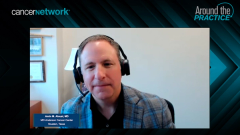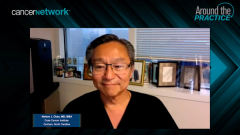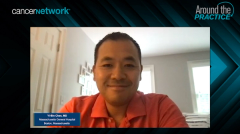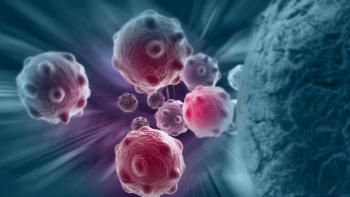
Treatment Armamentarium for Chronic Graft vs Host Disease
Comprehensive discussion on the pharmacologic treatment armamentarium available for patients with chronic graft vs host disease.
Episodes in this series

Transcript:
Yi-Bin Chen, MD: This patient was started on a systemic steroid at 16 months post-transplant. The patient experienced eye dryness for the first few months prior and had muscle and joint pain that was limiting her ability to exercise. Hana, how high dose of steroids would you go on this, and what are your triggers for starting? When do you start a second-line therapy?
Hana F. Safah, MD: With GVHD [graft-vs-host disease], we know when to start. But the guidelines afterward aren’t very clear. I’d start her on 1 mg/kg of steroid. I can start on 0.5 to 1 mg/kg. I tend not to go very high, and I give it enough time for a response to be documented with chronic GVHD. Right away, I add physical therapy. I add everything possible to help improve the quality of life of patients with chronic GVHD early on. I do that, and then I assess. It depends on what I’m treating. Is it mostly scleroderma, like skin changes? Or do I have diarrhea with it? Or is it liver? It depends on the organ that there’s involvement with. When it comes to the lung, I don’t want to wait too long. I follow the PFT [pulmonary function test] frequently in these patients. If there isn’t improvement in 14 to 28 days, then I have a second line.
This is where it depends on the organ that’s involved. If it’s the skin, and I see some scleroderma changes that aren’t going away and I want to taper faster, ECP [extracorporeal photopheresis] helps me a lot with chronic GVHD. If it’s the liver, the lung, and other organs being involved, I switch to a second-line agent and JAK inhibitors. JAK inhibitors are my go-to after 1 line of therapy failure. If it’s more, if a patient continues to not do well or cannot receive a JAK inhibitor for some reason, then ROCK inhibitors are another option. I don’t do too much ibrutinib [Imbruvica]. I’ve used it. It’s been difficult to maintain patients on ibrutinib. The trial was small and had adverse events, including bleeding and an effect on the platelet count. I don’t use ibrutinib because of the new agents that are available.
Yi-Bin Chen, MD: Let’s dive in there. You’re bringing out that steroids is the standard of care, but we’re all unhappy with that. These patients have gone through a lot, and steroids don’t work super well for chronic graft-vs-host disease. They cause a lot of harm in terms of toxicity, especially in older patients and those who have long-term steroid use for acute GVHD. Adding steroids back on, at this point, is really tough. We have 3 approved agents for refractory chronic graft-vs-host disease. They differ in the lines of therapy they’re approved for and so forth. Let’s go through each of them to understand the pros and cons.
I’ll touch on ibrutinib because you mentioned it. Ibrutinib is a Bruton tyrosine kinase inhibitor that many of us are familiar with in other settings. It targets the B-cell pathway. The B-cell pathway had been brought up when we talked about the physiology of chronic GVHD. There are other B-cell agents, such as rituximab [Rituxan], that people use. Ibrutinib was the first 1 approved. It was approved in a single-arm, 42-patient trial, which to many of us was surprising because it’s difficult to truly gauge efficacy for such a heterogenous disease when there’s no control. It had an overall response rate of over 70% and had some complete responses [CRs] as well. The problem in that trial, as many have brought up, is the highly selected population and the real-world experiences that have been published recently don’t live up to those trial results. There’s also toxicity with ibrutinib. Of all the agents we have, it causes a bit more immunosuppression than the others. There are also the known toxicities: cardiac, the GI [gastrointestinal] tract, bleeding, and so forth. I agree: I don’t use ibrutinib that much either.
There are exceptions for patients with underlying B-cell malignancies, which may help their antimalignancy effect. But you’re right. We at Massachusetts General Hospital try to use the other approved agents or other measures first. Most centers have shifted in that direction. Let’s talk about the others. After ibrutinib, the next agent that was approved was belumosudil [Rezurock]. Nelson, do you want to talk a about the mechanism of action, the data behind it, and how you’re using belumosudil?
Nelson J. Chao, MD, MBA: Belumosudil is a ROCK2 inhibitor, so it’s a Rho-associated coiled-coil protein kinase. That mechanism is thought to be a way to reduce T817 cells, which are cells known to be pro-inflammatory, and focus on these follicular helper cells that seem to increase Tregs [regulatory T cells]. The idea is that these 3 targets combine, improve, and decrease the process of chronic graft-vs-host disease. The data were quite remarkable. It was so well tolerated in a group of patients who tend to be relatively sick. The overall response rate was quite high, in the 70% range, although there weren’t a whole lot of CRs. It was interesting in that it seemed to have an impact on all organs, including the lungs. That’s an area in which the use will continue to grow. It’s approved in the second line, so you have to fail steroid therapy plus something else before use. In general, it’s been well tolerated.
Yi-Bin Chen, MD: We tend to sequence it after ruxolitinib because of its approval in that space. We talked a lot about ruxolitinib for refractory acute GVHD. That was the most recent approval in refractory chronic graft-vs-host disease. Amin, do you want to touch base on the data behind ruxolitinib approval? Has that become your standard for steroid-refractory chronic GVHD?
Amin M. Alousi, MD: One attraction to ruxolitinib data compared with the others is that these are the only data—of those compared with belumosudil and ibrutinib—studied in a randomized fashion against best-available therapy. Best-available therapy included a number of agents that could be selected by the center or the treating physician. It was compared against something, and it’s always nice to see that type of data. Similar to the data for belumosudil, these patients were pretty heavily treated for well-established chronic GVHD with multiorgan involvement. There was a preponderance of patients with moderate and severe chronic GVHD, similar to the data with belumosudil and, in comparison, similar to the earlier population studied with ibrutinib.
The data showed that the response rates were higher than in the best-available therapy, and looked similar in nature to belumosudil, with responses based on NIH [National Institutes of Health] consensus. Best overall responses approached 70%, and the data looked good. It was well tolerated, in terms of toxicities, when compared with best-available therapies. Cytopenias were surprisingly comparable with those best-available therapies. Infection rates were comparable as well. It was well tolerated and had activity in a pretty well established high-risk population.
Yi-Bin Chen, MD: Has it become your standard for steroid-refractory chronic graft-vs-host disease?
Amin M. Alousi, MD: I still select agents based on the patient in front of me, although understanding that comes from my personal experience. I don’t select it in preference to belumosudil in every patient. For some patients I turn to belumosudil. As Nelson mentioned, there was some excitement from the trial with belumosudil with respect to seeing some responses in lung GVHD. You couldn’t have severe lung GVHD and participate in that trial, so all of them had NAH 1 or 2 organ involvement. But a fairly large number of patients had that manifestation, and about a quarter of them responded. I’m used to seeing stabilization in lungs, not response, so there was some excitement around that. I may prefer it in that population. But ruxolitinib and belumosudil, off a clinical trial, are the 2 agents I turn to. For certain patients, I’ll consider ibrutinib. When I do, I tend to start at a lower dose and then escalate if I feel the need. Then I’ll consider what’s published based on the phase 2 trial.
Transcript edited for clarity.
Newsletter
Stay up to date on recent advances in the multidisciplinary approach to cancer.






















































































